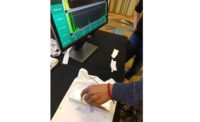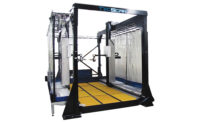
When the market for jet engines began to boom, so did the manufacture of creep test frames. Early frames were simply a gantry with a seesaw-type lever arm at the top. The front of the arm had a hinge rod attached to the specimen to be tested. The bottom of the specimen was attached to the frame.
The other end of the lever arm had a cast metal weight, providing a tension force. The arm, or seesaw, was set up with a 10- or 20-to-1 ratio, resulting in the desired tension with relatively small weights. Then a small tube furnace was wrapped around the specimen. Measurement apparatus, extensometer rods and usually a dial indicator to measure the creep displacement also were added.
This test used to be conducted completely manually, by checking temperatures and other variables regularly. Often two or three testers would take readings every half-hour around the clock. This setup was labor-intensive and prone to error, and early attempts to automate this process did not have wide success.

LVDTs are small analog measurement devices that need a signal conditioner to read them. These devices require a calibration procedure after setup, and then periodically as necessary. Somewhat temperature sensitive, the placement of the LVDT in an extensometer is critical. Because LVDTs are temperature-sensitive, their position values have a kind of drift or a natural significant coefficient of their measurement over time. These often work like a thermometer, as the high measurement readings will vary as the room temperature changes. When in use, testing data will actually reflect when the room air conditioning cycles on and off.
Around the year 2000, the design of an extensometer went through a dramatic shift as miniature gages became available. Due to the elimination of LVDTs, the use of a full-time operator is no longer necessary in the creep tests because recalibration and the resetting of any correction curves that must be done precisely at the right moments with an LVDT, is no longer necessary. A more reliable setup is now ensured and one using less manpower. This was a major consideration in the redesign.


Source: Heidenhain
Pratt & Whitney became the first to use these digital creep test systems in their jet engine manufacturing process. Many other manufacturers are now part of this trend, as well as some independent labs such as Dirats Laboratories, BodyCote Testing, Metcut Research, Stavely Services Materials Testing and U.S. Inspections.
In the United States, it is estimated that only about 20% of creep testers testing are equipped with this automated digital control systems. Though with the hundreds of testing facilities in operation in the United States, combined with the increasing and tightening demands and certification requirements placed upon them, this is clearly the next level for all.
BENEFITS
• Because the elimination of LVDTs, the use of a full-time operator is no longer necessary in the creep tests.• Heidenhain's Specto/Metro gages allow a longer range of measurement, from 12 to 100 millimeters on some gages, reducing the number of masters required.
• The scales also are much more accurate over longer distances, and when made of ceramics, have no thermal growth at all.
• Replacing analog LVDTs with digital gages permits automated testing along with higher reliability and accuracy.
Heidenhain Corp.
(847) 490-1191
www.heidenhain.com

